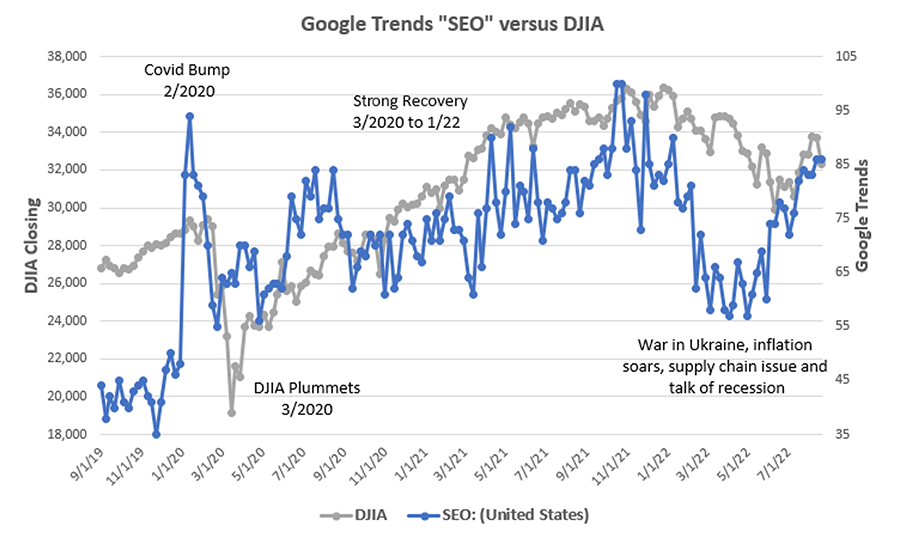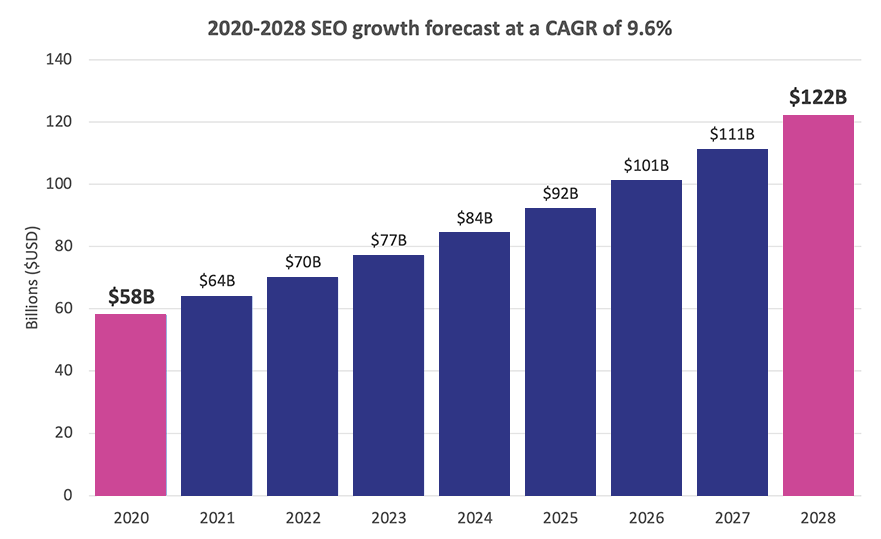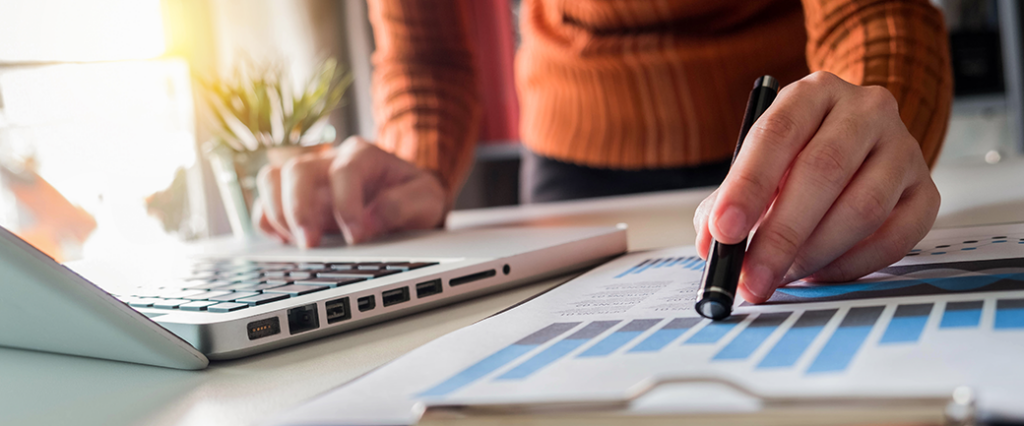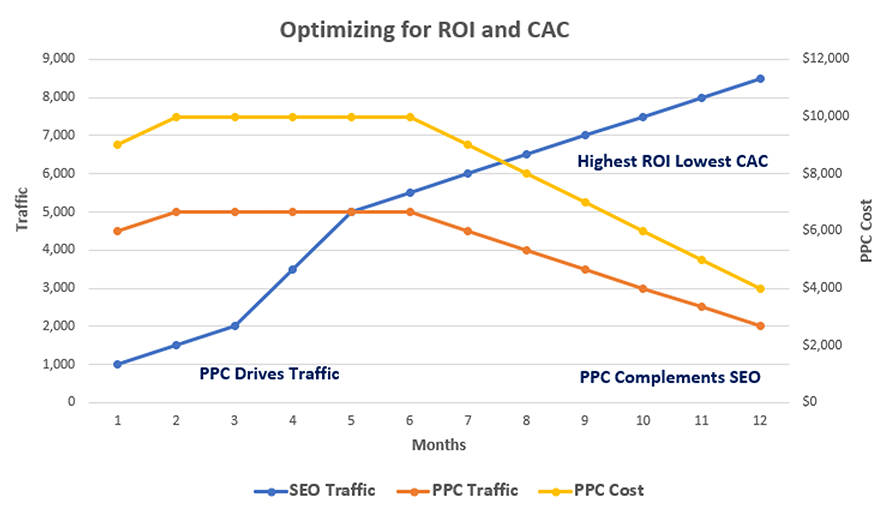SEO Investment Dynamics During Downturns
Between December 2019 and February 2020, Google Trends reported a meteoric spike in interest in the keyword “SEO”. This phenomenon has come to be known as the “Covid Bump” or “Covid Effect”. The world had suddenly become aware that Covid was going to have a dramatic impact on all our lives. Marketers, particularly eCommerce marketers, realized a dramatic shift to online shopping was at hand. Marketing budgets tightened, large-scale layoffs ensued, and the Nasdaq and DJIA declined sharply. Thankfully, the declines were short-lived, and a strong recovery followed. Even so, the SEO growth phenomenon continued at an accelerated pace—led by companies, agencies, and tool suppliers.

Why the increased investment? Even with budget cuts, marketers saw SEO as a stable, cost-effective alternative to paid media channels. Fast-forward to early 2022: war breaks out in Ukraine, inflation soars, fuel prices skyrocket, supply chains struggle to rebuild, and there is significant competition for talent recruitment. Marketers are once again considering how to best balance the paid and organic channel mix. In fact, all indications are that growth in SEO investments will continue for years to come.

Drivers for SEO Investment Regardless of Economic Conditions

Any marketer who follows search and purchasing trends knows online customer acquisition starts with search. Here are eight prominent 2022 SEO statistics to consider:
- 68% of online experiences begin with a search engine.
- 63% of all shopping begins online, even if the actual purchase happens in-store.
- Nearly 50% of consumers shop more on mobile than in-store.
- Nearly 1/3 of consumers in the U.S. use the internet to search for local businesses every day.
- 28% of local searches result in a purchase within 24 hours.
- Organic accounts for 71% of total click share.
- Organic search accounts for 53% of web traffic, twice as much as paid search (27%), and over ten times more than organic social (5%).
- Organic search is even more prevalent in certain verticals such as B2B (64%) and technology (60%).
Three Reasons SEO Investment is Your Best Move During an Economic Downturn

During economic downturns, companies economize. They may optimize their marketing mix by investing in SEO and decreasing paid media spend. Why?
- It prepares you for future success: Investing in SEO during a downturn means strong organic growth as the economy recovers.
- It’s a stabilization strategy: Good SEO rankings are long-lasting and provide predictable long-term growth, whereas paid media benefits cease the moment the spend is cut.
- It’s your highest financial impact channel: Compared to other marketing channels, SEO often provides the highest Return on Investment (ROI) and lowest Customer Acquisition Costs (CAC). Google itself says ROI on organic search is 5.3x versus 2x from paid search. These attributes make SEO an attractive alternative as economic conditions ebb and flow.
Resolving the ‘SEO or PPC’ Debate

Two Sides of the Same Coin
SEO and PPC both have strengths and weaknesses. SEO can be time-consuming, and it may take months to see results. Once achieved, however, organic positioning is relatively stable and generally drives traffic that converts at a higher rate than PPC. Due to its relatively strong ROI and low CAC, SEO can provide a strategic advantage over the competition (if they’re relying on PPC). By comparison, PPC is fast to implement, easy to scale, straightforward to measure, and allows for granular targeting. The downside is that PPC is like a faucet: someone has to pay the water bill each month. Rather than looking at SEO or PPC in isolation, your business will benefit greatly from a complimentary search engine strategy.
Working in Concert to Optimize Return on Investment and Customer Acquisition Costs
Early on, PPC drives highly targeted traffic for a cost. However, as SEO efforts gain traction and organic traffic increases, PPC costs can be reduced proportionally. Ultimately, SEO will increase your ROI and lower Customer Acquisition Costs. At this point, PPC can complement SEO efforts. For example, PPC could bid on terms that are difficult for SEO to rank for, increase spend on time-sensitive promotional activities, or increase traffic during peak traffic periods like the holiday season.

Navigating the Impending Death of the Third-Party Cookie
Data breaches and questionable business practices around consumer data have troubled companies like Google, Facebook, Amazon, and numerous others in recent years. As a result, the EU’s General Data Privacy Regulation (GDPR) and the California Consumer Privacy Act (CCPA) have mandated that tech companies revise their data collection practices. Many browsers have already discontinued the use of third-party cookies, and Google plans to follow suit in 2023. As channels dependent on third-party cookie tracking become outdated, SEO will become increasingly important to ensure consumers find your products and services. 2023 isn’t far off, but the advanced notice provides an excellent opportunity to diversify your channel mix and soften the impact of a cookie-less world. Getting an early start is key, as SEO takes time to bear fruit.
Our Advice: Improve First-Party Cookie Data Collection
First-party cookies are generated when users visit your site. These cookies may be used for storing passwords and other basic information, but they can also teach you a lot about user behavior. Tools like Google Search Console and Google Analytics can also help you understand user behavior. Combining the data gleaned from these tools with first-party cookie data can help to define audiences and how they interact with your content. This rich dataset can then be used to provide personalized results for users. Just remember that building rich first-party data takes time, so the sooner you get started the better.
The Bottom Line

SEO is your best long-term investment to drive better performance and impact while lowering acquisition costs. PPC augments that strategy, providing short-term boosts in traffic. With third-party cookies going away in 2023, economic forces are again forcing marketers to optimize their marketing channel mix.
Smart marketers acknowledge that 2023 is just around the corner, and they’re preparing for the future. If you want to continue to advance your digital agenda, you’d be wise to follow suit. Get in touch with us when you’re ready—we’ll help you take a closer look at your SEO strategy and reimagine your channel mix for a changing world.


